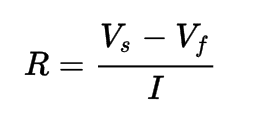Bill, voltage is an odd specification when talking LEDs. They don't have an "operating" voltage per se, at least not like you are accustomed to with other devices. LEDs have a voltage drop
across them, typically 1.7V - 3.5V. Termed forward voltage drop it is specified in the data sheet as V
f. The voltage applied must exceed the minimum voltage drop of the specific LED for the LED to light. Once the minimum voltage has been applied an LED becomes a current regulated device, not a voltage regulated device. The series resistor sets the
current level flowing through the LED which dictates how bright the LED emits.
So, when working with LEDs the variable that is important to you is the current, or more precisely, forward current. The maximum forward current value for a given LED will be specified in the data sheet as I
f. If you want the LED to be less than full brightness then decrease the forward current by increasing the value of the series resistor. Most LEDs will light with as little as 1mA of current or less. Here is the ultra handy formula you should use when working with LEDs:

R = resistor value
V
s = power supply voltage
V
f = LED forward voltage
I = LED forward current
Or even easier...
http://www.ohmslawcalculator.com/led-resistor-calculatorYou know a typical LED will light anywhere between 1mA and 20mA. Use the formula to determine the resistor value for 1mA and then the value for 20mA. Those two resistor values now become the min and max for whatever voltage you are using. Choose your brightness level by selecting a value somewhere between min and max. Notice that, other than as an operand in the formula, voltage doesn't matter to the LED. Hence, why voltage is an odd specification for an LED.
When suppliers advertise LEDs for different voltages (Evans) what they are really saying is "This LED has a series resistor of sufficient value to permit 20mA of current to flow at x voltage." The LEDs themselves are not different voltage LEDs because there is no such thing.